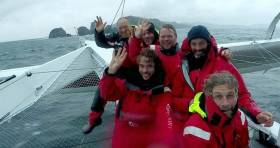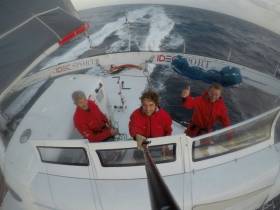Displaying items by tag: Jules Verne
Francis Joyon Sets a New Record at Cape Horn
The IDEC SPORT maxi-trimaran skippered by Francis Joyon crossed the longitude of Cape Horn, the last of the three major capes in the Jules Verne trophy at 0004 UTC on Thursday 12th January. After leaving Ushant on 16th December, Joyon and his crew of five, Clément Surtel, Sébastien Audigane, Bernard Stamm, Gwénolé Gahinet and Alex Pella have achieved the best intermediate time between Ushant and Cape Horn, completing this stretch in 26 days, 15 hours, 45 minutes some 4 days 6 hours and 35 minutes ahead of the reference time set by Banque Populaire V in 2012 (30 days, 22 hours and 19 minutes).
This is their fourth intermediate record including the Pacific Ocean record between the SE of Tasmania and Cape Horn with a time of 7 days 21 hours and 14 minutes (record held by Bruno Peyron since 2005 with a time of 8 days, 18 hours and 8 minutes).
IDEC-SPORT sailed the 18,332 miles out on the water between Ushant and Cape Horn at an average speed of 28.7 knots.
Jules Verne Trophy reference time / Banque Populaire V (2012): 45 days, 13 hours, 42 minutes and 53 seconds
Francis Joyon & IDEC Trimaran Reach Doldrums in Four Days
Frech offshore racers who are on their Round the world record bid for the Jules Verne Trophy have made great progress in the first few days of their record attempt. Francis Joyon and his crew of five aboard the IDEC SPORT maxi-trimaran will be facing the Doldrums late this evening. It will only have taken the elite squad four and a half days to reach this area of great instability, which stretches out a few degrees north of the Equator. The width and level of activity of this zone, where forecasts are not very reliable, will have a major effect on the time it takes the red and white maxi-trimaran to complete this first stretch of the Jules Verne Trophy. Averaging over thirty knots out on the water and 25.5 on the great circle route, Francis, Clément, Alex, Seb, Bernard and Gwéno have found just the right mixture of energy, concentration and vigilance to obtain a very good time between Ushant and the Equator. Will the final determining factor, the Doldrums, be kind to them? Joyon wants to believe so, stressing with a smile that “the Doldrums can't have it in for us twice.
With a lead of 100 miles at the start of this fifth day of racing, having sailed 3000 miles out on the water on a fairly straight course with just five minor gybes, Joyon's boys have made the most of a weather opportunity that was far from being ideal. Francis Joyon cannot explain that other than by pointing out how hard the lads have been working in a joyful atmosphere, where everyone has played their part in each watch. “It's true that with the short mast and small crew, there have been weight savings and IDEC SPORT is behaving really well in these relatively stable trade winds on fairly calm seas. We are able to get the most out of the boat and she cuts magnificently through the water, which makes it a real pleasure to be at the helm. The combination of sails in this wind angle works remarkably well.”
IDEC SPORT is about to tackle all the uncertainties of the Doldrums. After the deep annoyance of November's voyage in this zone, Joyon believes he will be lucky this time. He also believes in the advice and observations that Marcel van Triest is offering from ashore. He has seen an ideal entry point to get to the Southern Hemisphere at a longitude of 25 degrees west. The SE'ly trade winds can already be felt and should offer a decent crossing into the vagaries of the mighty South Atlantic.
The tiredness that they are bound to be feeling at this point has not dampened the enthusiasm and determination of the six sailors on IDEC SPORT, who are aiming to get their revenge in the Doldrums after their disappointment in November. Records are won through determination, enthusiasm, inspiration and talent, but luck also plays its part. The hand of fate could offer Joyon and his boys a well deserved reward this evening for their obstinacy.






























































